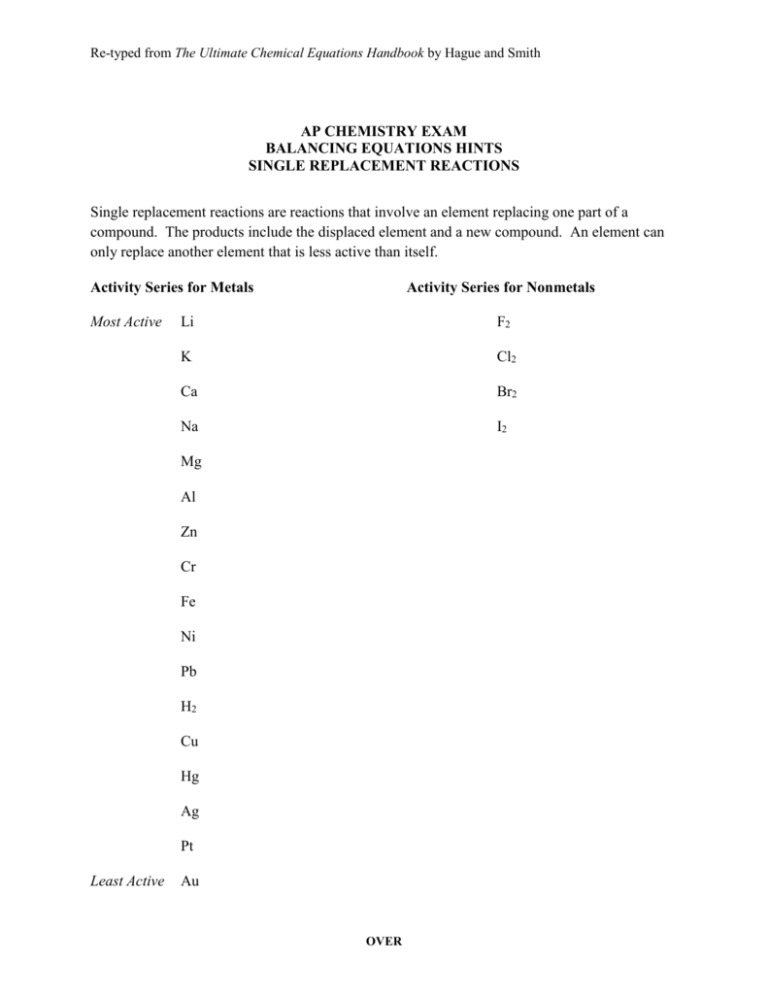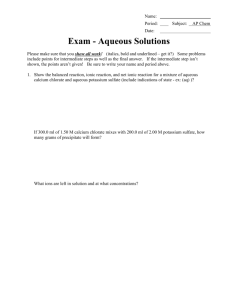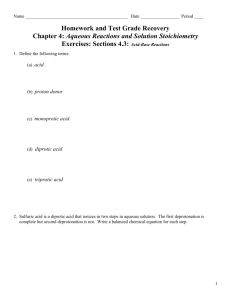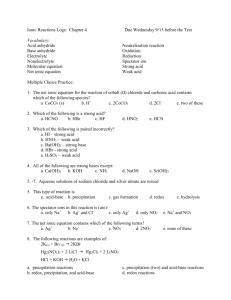
Re-typed from The Ultimate Chemical Equations Handbook by Hague and Smith
AP CHEMISTRY EXAM
BALANCING EQUATIONS HINTS
SINGLE REPLACEMENT REACTIONS
Single replacement reactions are reactions that involve an element replacing one part of a
compound. The products include the displaced element and a new compound. An element can
only replace another element that is less active than itself.
Activity Series for Metals
Most Active
Activity Series for Nonmetals
Li
F2
K
Cl2
Ca
Br2
Na
I2
Mg
Al
Zn
Cr
Fe
Ni
Pb
H2
Cu
Hg
Ag
Pt
Least Active
Au
OVER
Common types of single replacement reactions:
1. Active metals replace less active metals from their compounds in aqueous solutions.
Magnesium turnings are added to a solution of iron (III) chloride
2. Active metals replace hydrogen in water.
Sodium is added to water
3. Active metals replace hydrogen in acids
Lithium is added to hydrochloric acid
4. Active nonmetals replace less active nonmetals from their compounds in aqueous
solutions.
Chlorine gas is bubbled into a solution of potassium iodide
***** If a less active element is combined with a more reactive element in compound form,
there will be no reaction.
Re-typed from The Ultimate Chemical Equations Handbook by Hague and Smith
AP CHEMISTRY EXAM
PRACTICE - BALANCING EQUATIONS
***** Using the activity series, predict and balance the following single replacement reactions. Not all of the
reactions will occur. For those that do not, write NO REACTION.
1. A piece of copper is dropped into a container of water.
2. Liquid bromine is added to a container of sodium iodide crystals.
3. An aluminum strip is immersed in a solution of silver nitrate.
4. Zinc pellets are added to a sulfuric acid solution.
5. Fluorine gas is bubbled into a solution of aluminum chloride.
6. Magnesium turnings are added to a solution of lead (II) acetate.
7. Iodine crystals are added to a solution of sodium chloride.
8. Calcium metal is added to a solution of nitrous acid.
9. A pea-sized piece of lithium is added to water.
10. A solution of iron (III) chloride is poured over a piece of platinum wire.
OVER
AP CHEMISTRY EXAM
BALANCING EQUATIONS HINTS
DOUBLE REPLACEMENT REACTIONS
In many reactions between two compounds in aqueous solution, the cations and anions appear to
switch partners according to the following equation:
AX + BY → AY + BX
The two compounds react to form two new compounds. No changes in oxidation numbers
occur. Reactions of this type are known as double replacement reactions. An example of such a
reaction would be the mixing of aqueous solutions of potassium bromide and silver nitrate to
form solid silver bromide (precipitate) and aqueous potassium nitrate:
KBr (aq) + AgNO3 (aq) → AgBr (s) + KNO3 (aq)
Note that each cation pairs up with the anion in the other compound, thus switching partners.
Anions do not pair up with anions and cations do not pair up with cations.
All double replacement reactions must have a “driving force”, or a reason why the reaction will
occur, or “go to completion”. The driving force is the removal of at least one pair of ions from
solution.
The removal of ions can occur in one of three ways:
1. Formation of a precipitate: A precipitate is an insoluble substance (solid) formed by the
reaction of two aqueous substances. It is the result of ions bonding together so strongly that the
solvent (water) cannot pull them apart. The insoluble solid (or solids if a double precipitate
occurs) will settle out (precipitate) from the solution and this results in the removal of ions from
the solution.
2. Formation of a gas: Gases may form directly in a double replacement reaction or from the
decomposition of one of the products. The gases will bubble off or evolve from the solution.
3. Formation of a primarily molecular species: The formation of primarily unionized
molecules in solution remove ions from the solution and the reaction “works”, or is said to go to
completion. Unionized, or partially ionized, molecules give solutions that are known as
nonelectrolytes or weak electrolytes. The best known nonelectrolyte is water formed in acidbase neutralization reactions. Acetic acid is an example of an acid that is primarily molecular
(weak electrolyte) when placed in water.
Re-typed from The Ultimate Chemical Equations Handbook by Hague and Smith
Reversible Reactions
If a double replacement reaction does not go to completion (no precipitate, gas, or molecular
species is formed), then the reaction is reversible (no ions have been removed). Reversible
reactions are at equilibrium and have both forward and reverse reactions taking place. In a
reversible reaction, evaporation of the water solvent will result in solid residues of both reactants
and products. The reaction is not driven to completion (products) because no ions have been
removed. A double arrow is used to designate a reversible reaction at equilibrium.
BaCl2 (aq) + 2 NaNO3 (aq) ↔ Ba(NO3)2 (aq) + 2 NaCl (aq)
Table 4.1 Simple Rules for the
Solubility of Salts in Water
Copyright © Houghton Mifflin Company. All rights reserved.
4–45
OVER
MAINLY WATER SOLUBLE
NO3 -
All nitrates are soluble
CH3COO- or C2H3O2 -
All acetates are soluble except AgCH3COO
ClO3 -
All chlorates are soluble
Cl -
All chlorides are soluble except AgCl, Hg2Cl2, PbCl2
Br -
All bromides are soluble except AgBr, PbBr2, Hg2Br2,
HgB2
I-
All iodides are soluble except AgI, Hg2I2, HgI2, PbI2
All sulfates are soluble except BaSO4, PbSO4, Hg2SO4,
SO4
2-
CaSO4, Ag2SO4, SrSO4
Alkali metal cations (Group 1) and NH4 +
All are soluble
H+
All common inorganic acids and low molecular weight
organic acids are soluble
MAINLY WATER INSOLUBLE
CO3 2-
CrO4
2-
All carbonates are insoluble except those of the Group 1
elements and NH4 +
All chromates are insoluble except those of the Group 1
elements, NH4 +, CaCrO4, SrCrO4
OH -
All hydroxides are insoluble except those of the Group 1
elements, NH4 +, Ba(OH)2, Sr(OH)2, Ca(OH)2
PO4 3-
All phosphates are insoluble except those of the Group 1
elements and NH4 +
SO3 2-
All sulfites are insoluble except those of Group 1, H4 +
S 2-
All sulfides are insoluble except those of the Group 1
and Group 2 elements and NH4 +
Formation of a Precipitate
Re-typed from The Ultimate Chemical Equations Handbook by Hague and Smith
In order to predict double replacement reactions yielding precipitates, one must memorize the
solubility rules.
***** Predict and balance the following double replacement reactions based on the solubility
rules. Use the abbreviations (aq) and (s) for all reactants and products. All reactants are
aqueous. Some of these reactions do not go to completion.
1. silver nitrate + potassium chromate
2. ammonium chloride + cobalt (II) sulfate
3. lithium hydroxide + sodium chromate
4. zinc acetate + cesium hydroxide
5. ammonium sulfide + lead (II) nitrate
6. iron (III) sulfate + barium iodide
OVER
7. chromium (III) bromide + sodium nitrate
8. rubidium phosphate + titanium (IV) nitrate
9. ammonium carbonate + nickel (II) chloride
10. tin (IV) nitrate + potassium sulfite
Re-typed from The Ultimate Chemical Equations Handbook by Hague and Smith
AP CHEMISTRY EXAM
BALANCING EQUATIONS HINTS
DOUBLE REPLACEMENT REACTIONS
FORMATION OF A GAS
Common gases formed in double replacement (metathesis) reactions are:
H2 S – any sulfide (salt of S2-) reacts with any acid to form H2S (g) and a salt.
CO2 – any carbonate (salt of CO3-) reacts with any acid to form CO2 (g) plus HOH and a salt.
SO2 – any sulfite (salt of SO32-) reacts with any acid to form SO2 (g) plus HOH and a salt.
NH3 – any ammonium salt (salt of NH4+) reacts with any soluble strong hydroxide when heated
to form NH3 (g), HOH, and a salt.
Reactions that produce three of the gases (CO2, SO2, and NH3) involve the initial formation of a
substance that breaks down to give the gas and HOH.
Example 1: The reaction of Na2SO3 and HCl produces H2SO3 and aqueous sodium chloride:
Bubbling is observed in this reaction because the H2SO3 (sulfurous acid) is unstable and
immediately decomposes to give HOH and SO2 gas:
The molecular equation for the complete reaction is:
Example 2: A typical reaction of a carbonate and an acid is:
Bubbling is also observed in this reaction. Theoretically, H2CO3 (carbonic acid) is formed. But,
the acid is unstable and immediately decomposes to form carbon dioxide and water according to
the following equation:
OVER
Example 3: Ammonium salts and soluble bases react as follows (particularly when the solution
is warmed):
The odor of ammonia is detected and moist red litmus paper held near the mouth of the container
will turn blue. Theoretically NH4OH, ammonium hydroxide, is produced (also known as
ammonia water). The compound is unstable and decomposes into ammonia gas and water:
Example 4: The odor of rotten eggs and bubbling are noted when an acid is added to a sulfide.
A typical reaction producing hydrogen sulfide gas is:
***** Predict and balance the following double replacement reactions based on the solubility
rules. Use the abbreviations (s), (l), (g), and (aq) for all reactants and products. All reactants are
aqueous unless otherwise stated.
1. ammonium sulfate and potassium hydroxide are mixed.
2. ammonium sulfide is reacted with hydrochloric acid
3. cobalt (III) chloride is combined with silver nitrate
4. solid calcium carbonate is reacted with sulfuric acid
5. potassium sulfite is reacted with hydrobromic acid
Re-typed from The Ultimate Chemical Equations Handbook by Hague and Smith
6. potassium sulfide is reacted with nitric acid
7. ammonium iodide + magnesium sulfate
8. solid titanium (IV) carbonate + hydrochloric acid
9. solid calcium sulfite + acetic acid
10. strontium hydroxide + ammonium sulfide
OVER
AP CHEMISTRY EXAM
BALANCING EQUATIONS HINTS
DOUBLE REPLACEMENT REACTIONS
FORMATION OF A MOLECULAR SPECIES
Weak or Nonelectrolytes
Double replacement reactions that produce primarily molecules in the form of partially
dissociated or ionized molecules (weak electrolytes) or molecules that do not ionize or dissociate
at all (nonelectrolytes) serve as the driving force in some aqueous reactions. Forming molecular
products in double replacement reactions results in the removal of ions from solution. Such
reactions tend to go to completion and form primarily products.
Simplified list of rules:
A. The common strong acids, and thus strong electrolytes, are HClO4, HClO3, HCl, HBr, HI,
HNO3, and H2SO4. (Memorize these seven strong acids). All other common acids are weak
acids and thus weak electrolytes (CH3COOH, H3PO4, HF, and HNO2). All organic acids
(R-COOH) are weak electrolytes. All strong acids in their pure form (as opposed to dilute
aqueous form) are nonelectrolytes (molecular). When water is added, the action of the solvent
water with a strong acid produces a hydrated proton (hydronium ion) and a negatively charged
anion. The process of making ions from molecular species is known as ionization.
HCl (g) + H2O (l) → H3O+ (aq) + Cl- (aq)
Or
HCl (aq) → H+ (aq) + Cl- (aq)
B. The common strong bases are the soluble hydroxides (those of Group 1 elements and Ba2+)
and the slightly soluble hydroxides of Ca2+ and Sr2+. Strong bases, like strong acids, are strong
electrolytes. Memorize the strong bases. Pure liquid hydroxides are strong electrolytes because
they already contain ions. The action of the solvent releasing the ions of a base into solution is
known as dissociation. Acids ionize in water; bases dissociate.
C. Most common (soluble) salts are strong electrolytes and thus dissociate into ions when placed
in water.
D. Water is a weak electrolyte which is typically produced in acid-base neutralization reactions.
Example 1: The reaction of calcium acetate and hydrochloric acid:
Re-typed from The Ultimate Chemical Equations Handbook by Hague and Smith
Example 2: The reaction of sodium phosphate and sulfuric acid:
Acid-Base Neutralization Reactions
Acids react with bases to produce salts and water. One mole of hydrogen ions will react with
one mole of hydroxide ions to produce one mole of water. Learn which acids are strong acids
(written in ionic form) and which are weak acids (written in molecular form). Check the
solubility rules for the solubility of the salt formed. If it is soluble, it is written in ionic form; if it
is insoluble, it is written in molecular form.
Acid + Base → Salt + Water
Example 1: Hydrogen sulfide gas is bubbled through excess potassium hydroxide solution.
Polyprotic acids can be tricky when it comes to predicting neutralization reactions. Sulfuric acid
and phosphoric acid are classic examples frequently encountered on AP exams. If the base is in
excess, all hydrogen ions will react with the strong base to produce water.
Example 2: Dilute sulfuric acid is reacted with excess sodium hydroxide.
If, however, the reaction states that equal numbers of moles of acid and base react then the
coefficients for both reactants must be one and the salt that forms is different.
Example 3: Equal number of moles of sulfuric acid and sodium hydroxide react.
Take into account information dealing with the quantity of each reactant.
OVER
Example 4: Equal volumes of 0.1 M phosphoric acid and 0.2 M sodium hydroxide are reacted
together.
Watch for substances that react with water before reacting with an acid or a base. The acid and
basic anhydrides behave in such a manner. These are really two-step reactions.
Example 5: Excess sulfur dioxide is bubbled into a saturated solution of calcium hydroxide.
If an acid + base yields salt + water, then an acid anhydride + basic anhydride will yield a salt.
Example 6: Sulfur dioxide gas and solid calcium oxide are reacted together.
***** Predict and balance the following double replacement reactions based on the solubility
rules. Use the abbreviations (s), (l), (g), and (aq) for all reactants and products. All reactants are
aqueous unless otherwise stated.
1. carbon dioxide gas is bubbled through a solution of lithium hydroxide
2. sodium nitrite is reacted with hydrochloric acid
3. ammonium bromide + sodium hydroxide
Re-typed from The Ultimate Chemical Equations Handbook by Hague and Smith
4. carbon dioxide gas is reacted with solid potassium oxide
5. solid magnesium oxide is reacted with hydrochloric acid
6. equal numbers of moles of potassium hydroxide and phosphoric acid react
7. sodium fluoride reacts with dilute nitric acid
8. ammonium carbonate + potassium bromide
9. oxalic acid (0.1 M) reacts with an equal volume of cesium hydroxide (0.1 M)
10. silver nitrate + sodium chromate
OVER
AP CHEMISTRY EXAM
BALANCING EQUATIONS HINTS
AQUEOUS SOLUTIONS AND IONIC SOLUTIONS
Introduction
For the most part, all the reactions we have looked at so far have been written as if the reactants
and products were all molecular. No explicit indications were made that soluble compounds had
dissociated or ionized into ions. This is not necessarily how reactions really work. It is also not
how reactions are expected to be written on the AP exam.
Overall (Total) Ionic Equations
In overall or total ionic equations, formulas of the reactants and products are written to show the
predominant form of each substance as it exists in aqueous solution. Soluble salts, strong acids,
and strong bases are written as separated ions. Insoluble salts, suspensions, solids, weak acids,
weak bases, gases, water, and organic compounds are always written as individual molecules.
Example 1: The reaction of cadmium nitrate and sodium sulfide:
Molecular equation:
Total ionic equation:
This equation illustrates that cadmium nitrate dissociates into three ions (one Cd2+ ions and two
NO3- ions); sodium sulfide dissociates into three ions (two Na+ ions and one S2- ion); the soluble
sodium nitrate remains dissociated in ion form while the insoluble cadmium sulfide is
undissociated in the solid form.
The following questions should help to determine if formula units should be written as separate
ions or as uncharged molecules in an overall ionic equation:
(1) Does the substance dissolve in water? If no, write the molecular formula. If yes, see below.
(2) If the substance dissolves in water, does it dissociate into either a salt or a strong base? If yes,
write the ionic form of the formula; if no, write the molecular formula.
(3) If the substance dissolves in water, does it ionize into a strong acid? If yes, then write the
ionic form of the formula; if no, write the molecular formula.
Re-typed from The Ultimate Chemical Equations Handbook by Hague and Smith
The only common substances that should be written as ions in ionic equations are:
SOLUBLE SALTS
STRONG ACIDS
STRONG BASES
You must memorize the solubility rules, the list of strong acids, the list of strong bases, and the
formulas of the polyatomic ions. There is no other way to be successful balancing reactions
without this knowledge.
Example 2: Aqueous solutions of sulfuric acid and excess sodium hydroxide are reacted:
Molecular equation:
Total ionic equation:
Example 3: Excess aqueous acetic acid reacts with aqueous sodium sulfite:
Molecular equation:
Total ionic equation:
Example 4: Aqueous solutions of potassium chromate and silver nitrate are reacted together:
Molecular equation:
Total ionic equation:
Example 5: Methane gas is completely burned in air:
Molecular equation:
Total ionic equation:
OVER
Hydrolysis Reactions
The reaction of a salt with water to form molecular species is known as hydrolysis. Hydrolysis is
the reverse of neutralization and results when a salt plus water yields an acid plus a base.
Hydrolysis reactions deal with the formation of a weak acid and/or a weak base. Salts are the
product of neutralization, but salts that undergo hydrolysis usually are not neutral.
General hydrolysis reaction: salt + HOH → acid + base
MA + HOH → HA + MOH
*** Salts of a strong acid + a weak base will always hydrolyze to give an acidic solution.
Example 1: Aqueous ammonium chloride undergoes hydrolysis when placed in water:
Ammonium chloride is a salt made from a strong acid (HCl) and a weak base (NH4OH). In an
aqueous solution, ammonium chloride will hydrolyze to produce molecular ammonium
hydroxide (a weak base) and ionic hydrochloric acid (a strong acid). Ammonium chloride
hydrolyzes to produce an acidic solution because the free hydronium ions in solution outnumber
the free hydroxyl ions in solution (H3O+ > OH-). Molecular ammonium hydroxide has tied up
most of the hydroxide ions.
*** Salts of a weak acid + a strong base will always hydrolyze to give a basic solution.
Example 2: aqueous potassium fluoride undergoes hydrolysis when placed in water:
Potassium fluoride is a salt made from a weak acid (HF) and a strong base (KOH). In an
aqueous solution, KF will hydrolyze to produce molecular HF (a weak acid) and ionic KOH (a
strong base). KF hydrolyzes to produce a basic solution because the free hydroxyl ions in
solution outnumber the free hydronium ions in solution (H3O+ < OH-). Molecular hydrofluoric
acid has tied up most of the hydronium ions.
Re-typed from The Ultimate Chemical Equations Handbook by Hague and Smith
*** Salts of a strong acid + a strong base never undergo hydrolysis – the resulting solution is
always neutral.
Example 3: sodium chloride and water are mixed:
Sodium chloride (NaCl) is a salt produced from the neutralization of a strong acid (HCl) and a
strong base (NaOH). In an aqueous solution, NaCl does not undergo hydrolysis; no molecular
acid or base is produced. The net result is a neutral solution (H3O+ = OH-). Neither the
hydronium nor the hydroxyl ions are tied up by a weak acid.
*** Salts of a weak acid + salts of a weak base may hydrolyze as an acid, base, or neutral
solution; the final result depends on the Ka of the acid and the Kb of the base formed during
the hydrolysis process.
Example 4: ammonium fluoride and water are mixed together:
Ammonium fluoride is a salt produced by the neutralization of a weak acid (HF) and a weak base
(NH4OH). In an aqueous solution, ammonium fluoride will hydrolyze to produce molecular HF
and molecular NH4OH.
If the weak acid formed in hydrolysis is stronger than the weak base formed, the overall solution
will be slightly acidic.
If the weak base formed in hydrolysis is stronger than the weak acid formed, the overall solution
will be slightly alkaline (basic).
If the weak acid and base formed during hydrolysis are of equal strength, the overall solution
will be neutral.
OVER
***** Write balanced total ionic equations for the following reactions. Use the abbreviations
(s), (l), (g), and (aq) for all reactants and products. All reactants are aqueous unless otherwise
stated.
1. nickel (II) nitrate + cesium hydroxide
2. equal volumes of equal molar concentrations of sulfuric acid + sodium hydroxide
3. solid potassium chlorate is strongly heated
4. potassium tartrate solution + water
5. solid lithium metal is added to water
6. magnesium nitrate + sodium bromide
Re-typed from The Ultimate Chemical Equations Handbook by Hague and Smith
7. oxalic acid and excess potassium hydroxide
8. solid cobalt (II) hydroxide + hydroiodic acid
9. manganese (II) sulfate undergoes hydrolysis when placed in water
10. sodium carbonate + chlorous acid
OVER
AP CHEMISTRY EXAM
BALANCING EQUATIONS HINTS
NET IONIC EQUATIONS
Overall (Total) Ionic Equations
A net ionic equation is written to show only the species that react or undergo change in aqueous
solution. The net ionic equation is obtained by eliminating the spectator ions from an overall
ionic equation. All that is left are the ions that have changed chemically.
Example 1: The reaction of cadmium nitrate and sodium sulfide:
Molecular equation:
Total ionic equation:
Net ionic equation:
Example 2: Aqueous solutions of sulfuric acid and excess sodium hydroxide are reacted:
Molecular equation:
Total ionic equation:
Net ionic equation:
Re-typed from The Ultimate Chemical Equations Handbook by Hague and Smith
Example 3: Excess aqueous acetic acid reacts with aqueous sodium sulfite:
Molecular equation:
Total ionic equation:
Net ionic equation:
Example 4: Aqueous solutions of potassium chromate and silver nitrate are reacted together:
Molecular equation:
Total ionic equation:
Net ionic equation:
Example 5: Methane gas is completely burned in air:
Molecular equation:
Total ionic equation:
Net ionic equation:
OVER
Example 6: Aqueous ammonium chloride undergoes hydrolysis when placed in water:
Molecular equation:
Total ionic equation:
Net ionic equation:
Example 7: aqueous potassium fluoride undergoes hydrolysis when placed in water:
Molecular equation:
Total ionic equation:
Net ionic equation:
Example 8: sodium chloride and water are mixed:
Molecular equation:
Total ionic equation:
Net ionic equation:
Re-typed from The Ultimate Chemical Equations Handbook by Hague and Smith
Example 9: ammonium fluoride and water are mixed together:
Molecular equation:
Total ioninc equation:
Net ionic equation:
***** Write balanced net ionic equations for the following reactions. Use the abbreviations (s),
(l), (g), and (aq) for all reactants and products. All reactants are aqueous unless otherwise stated.
1. nickel (II) nitrate + cesium hydroxide
2. equal volumes of equal molar concentrations of sulfuric acid + sodium hydroxide
3. solid potassium chlorate is strongly heated
4. potassium tartrate solution + water
OVER
5. solid lithium metal is added to water
6. magnesium nitrate + sodium bromide
7. oxalic acid and excess potassium hydroxide
8. solid cobalt (II) hydroxide + hydroiodic acid
9. manganese (II) sulfate undergoes hydrolysis when placed in water
10. sodium carbonate + chlorous acid









